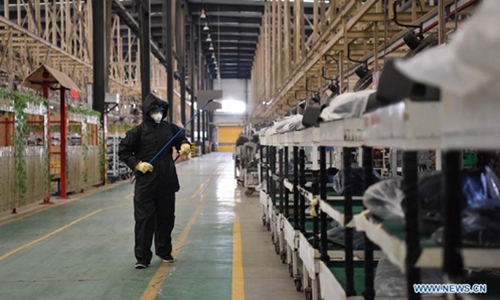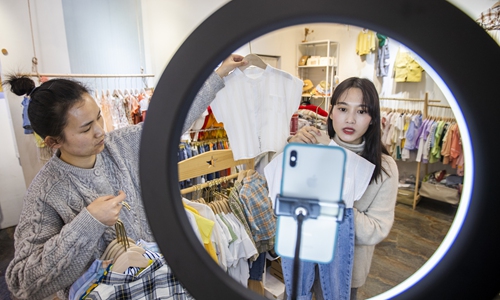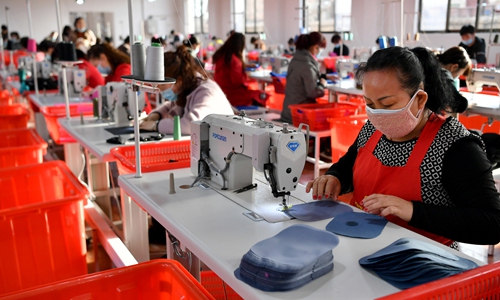Navigating economy in 2020
Chinese economists predict tough Q2, pick up steam later on

A worker disinfects the factory of Chang'an Automobile in Dingzhou, north China's Hebei Province, February 16, 2020. Photo: Xinhua/Zhu Xudong
To set an annualized GDP target or not, that's the question for the world's second largest economy in 2020, a year that seems tougher than ever, touched upon by some influential Chinese economists interviewed by the Global Times.
With the coronavirus black swan, which has hit the Chinese economy and increasingly battered the global economy in roaring on, mapping out China's growth targets, an eagerly anticipated yearly event that's traditionally unveiled at the annual two sessions, has turned into a hot potato, economists indicated.
China should set a GDP growth target for 2020 to coordinate economic growth amid the coronavirus pandemic, Li Daokui, a former advisor to China's central bank, said, suggesting a 4-5.6 percent range for the nation to add 11 million new jobs, a prerequisite for social stability.
"Just like a baton that coordinates all musicians in a troupe, a GDP goal is supposed to give businesses and capital markets a direction to strive for," Li, now a professor at Tsinghua University, told the Global Times, noting that the country's fast economic growth over the past 40 years is partially attributed to GDP goals.
The damage inflicted by the epidemic should be held to a minimum, a meeting of the Political Bureau of the Communist Party of China's Central Committee said on Friday, urging efforts to achieve this year's economic and social development goals and tasks including building a moderately prosperous society in all aspects and eradicating poverty.
Li said this task also includes doubling per capita income in 2020 from what it was in 2010, which means the country's GDP growth has to reach 5.5 or 5.6 percent.
The nation lowered its growth target for 2019 to 6-6.5 percent range from about 6.5 percent set for 2018, and eventually etched out a 6.1 percent expansion last year, the slowest pace in nearly three decades, per official data.
In the eyes of Guan Tao, global chief economist of BOCI Securities Ltd, whether setting a 2020 GDP target or not has its own advantages and disadvantages.
"What economic growth rate is acceptable should be based on strict and precise analysis rather than administrative order," Guan, a former senior official with China's foreign exchange regulator, told the Global Times, noting that even if a short-term target is achieved by certain policies, that may challenge long-term economic development.
Arguing against setting an annual growth target, Yao Yang, director of the China Center for Economic Research and dean of the National School of Development at Peking University, said the Chinese economy is under immense pressure from the pandemic, rendering setting a certain growth target pointless.
The economy is estimated to post a contraction of about 10 percent in the first quarter, according to him, it would have a tough time during the first two months of the second quarter before picking up steam later on.
A modest expansion of up to 3 percent for the whole year would be good enough, Yao told the Global Times.
"We think the government will likely lower sharply or de-emphasize growth target for 2020," UBS economists led by Wang Tao also said in a research note sent to the Global Times on Wednesday.

Employees of a children's clothing store in Wenzhou, East China's Zhejiang Province, held a live broadcast featuring children's wear on Tuesday. As consumption gradually recovers from the fallout of COVID-19, more businesses are seeking opportunities online. Photo: CNSphoto
Recession woes
It's generally expected that ugly readings would dominate economic data across the globe for the first quarter, posing uncertainty for the economic outlook to be pictured going forward.
A recession has already hit the global economy whose recovery is contingent upon the prospects for the coronavirus dragging on and vaccines that could effectively treat the disease and thus rein in the pandemic. It's likely that a stunning economic expansion could be booked for next year factoring in a lower base this year, Yao forecasts.
UBS economists estimated China's economic growth may have declined more sharply than previously expected to record a contraction of 10 percent, owing to slower-than-anticipated pace of growth normalization in March. They navigate the economy for the remainder of the year with more optimism than Yao, seeing the nation's GDP growth to rebound sharply in the second quarter, albeit with some headwinds.
The World Bank predicted in its latest report that growth in developing economies in East Asia and the Pacific would drop to 2.1 percent this year from 5.8 percent in 2019 in a baseline scenario, assuming that there would be sustained recovery of economic activities after the onslaught of the virus.
The bank called for rolling out macroeconomic measures to cushion against temporary shocks from having permanent effects, especially for the most economically vulnerable, while urging WTO members to adopt open trade policies in avoidance of further impacts on global supply chains.
Economists from China International Capital Corporation (CICC) said in a recent report that the US unemployment rate may grow rapidly in April and May, as the COVID-19 dealt a direct blow to the nation's services sector.
A record 3.28 million Americans filed for jobless benefits for the week ending on March 21. History shows there is a big chance of US jobless rate topping 10 percent following such massive jobless claims, CICC economists believe.
They reckon more US economic indexes may drop to historical lows in the upcoming months, with its actual annualized GDP for the second quarter plunging 28 percent from the previous quarter, which could count as its biggest contraction since the end of World War II.
A JPMorgan Chase Institute analysis of nearly 600,000 small businesses in the US in February-October 2015 revealed that half of these businesses hold a cash buffer sufficient enough to sustain 27 days of their typical outflows and restaurants only hold 16 days of cash buffers in reserve.
A raft of monetary and fiscal measures having been taken by the US, including an unlimited quantitative easing plan, would help in stabilizing the stock market in that they prevent the market from toppling, thereby holding off a financial crisis, but it can't help the US economy much, as the economy has now been largely halted, according to Peking University's Yao.
The US' helicopter money approach to save the virus-ravaged economy is equivalent to "drinking poison to quench thirst," he commented.

Workers manufacture suitcases at a factory in Yaozhou District of Tongchuan City, northwest China's Shaanxi Province, March 12, 2020. (Xinhua/Liu Xiao)
Consumption revival key to growth
Prevailing low consumption is the biggest concern for the coronavirus-hit Chinese economy, according to Yao.
Life services providers such as hair salons, barbershops and nail salons have employed many people, but reopening of such facilities is still a concern and consumers are seen still staying away from these non-essential services. The catering sector where a big percentage of the workforce is employed has taken a hit from the coronavirus, with "restaurants and eateries currently up and running at levels as high as only 40 percent of where they were prior to the viral outbreak, per my observation," he went on to say.
That would suggest about 60 percent of those working for the catering sector could now be furloughed or jobless.
Final consumption contributed to nearly 60 percent of China's GDP growth in 2019, official data showed.
The pandemic that has paralyzed a large part of the global economy with many nations including the US instituting lockdowns or issuing stay-at-home orders would inevitably ravage export-oriented businesses, prompting the consumer sector to play a bigger role in propping up the economy, according to observers.
Local governments have ramped up efforts to boost consumption, but consumers still appear hesitant to spend, partly due to the lingering fears of the viral onslaught, Yao remarked. As well as concerns over imported cases, the issue with asymptomatic patients is considered to have dampened consumers' plans to shop outdoors.
China is set to publish details of asymptomatic infections on a daily basis starting Wednesday. By Monday, a total of 1,541 asymptomatic patients, including 205 imported cases, had been under medical observation in the country.
Guan called for more measures to bail out domestic businesses and families hit hardest by COVID-19. "The central government has injected money to effectively expand infrastructure investment to boost the economy, but more fiscal expenditures should be set aside to improve people's livelihoods. Only if companies survive, can the domestic economy promptly restart after the onslaught of the new virus," he said.
Guan said the government should consider how to help domestic companies and factories solve problems and reduce burdens, as well as how to develop the domestic market at a time when exports are limited.
"Of course, companies shouldn't totally rely on governments, they also need to find opportunities for revenue recovery," he said.
Roughly 40 percent of US households have no savings, therefore a pause in economic activity means they would have no income and consequently be unable to survive, making cash handouts, like what's included in the US' $2.2 trillion worth rescue package, an essential solution to the current emergency situation. In the case of China, cash aid to needy families and jobless people can be considered while massive cash handouts don't make much sense, Yao remarked.
The popularity of online shopping can't offset coronavirus-incurred losses on the brick-and-mortar side, he said, adding that handouts of prepaid consumption vouchers in some cities in amounts tantamount to a tiny fraction of total retail sales of social consumer goods, can't be relied on to spur consumption.
In a sweeping move, cities including Hangzhou, Nanjing and Chongqing have revealed plans to dole out a multitude of vouchers carrying a face value of mostly between 5 yuan ($0.71) and 100 yuan for catering, travel, leisure and telecom services payouts. To get the vouchers that allow for a discount by varying degrees on spending, residents in cities like Nanjing and Chongqing need to win a lottery.
The most effective way to boost consumption is to hold the annual two sessions in April, which could send a strong signal to average folks who would be accordingly motivated to indulge in outdoor spending activities, Yao suggested.
"If deputies attending the two sessions are seen sitting inside the Great Hall of the People without wearing face masks, average consumers will feel at ease with spending," he said, adding the deputies could sit at a distance from each other or parallel venues can be arranged.
The central government needs to make up its mind regarding the two sessions, the economist argued, noting that it could serve as a much-needed catalyst for a revival in consumption right before the five-day May Day holidays.